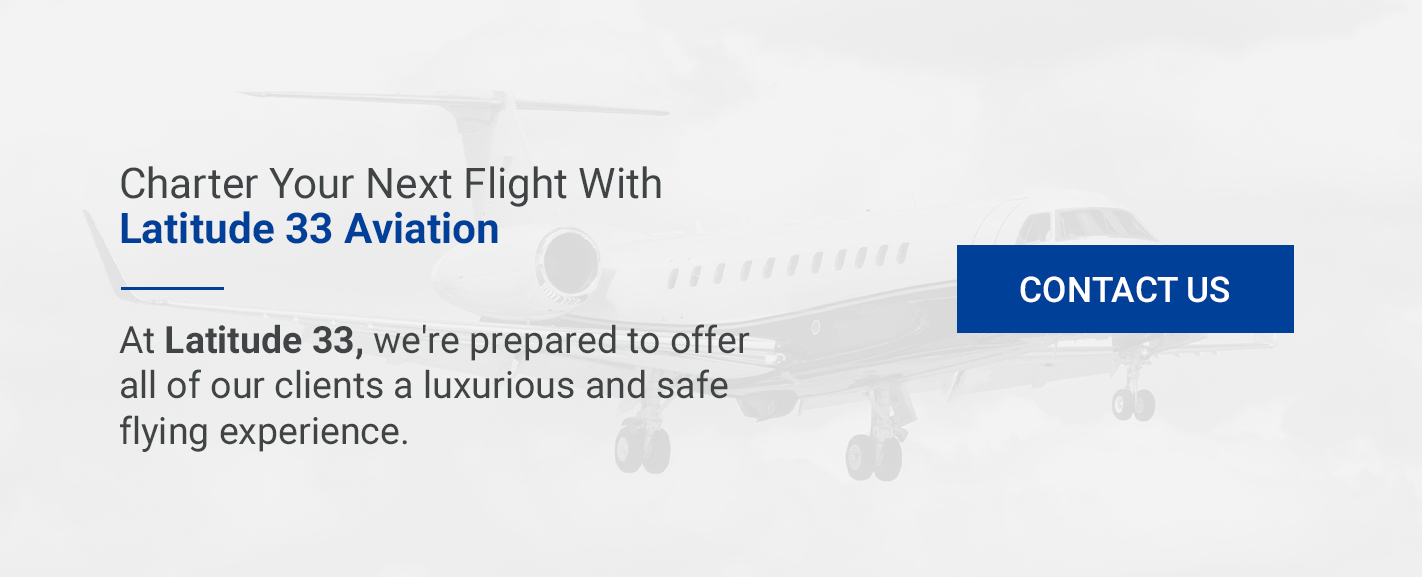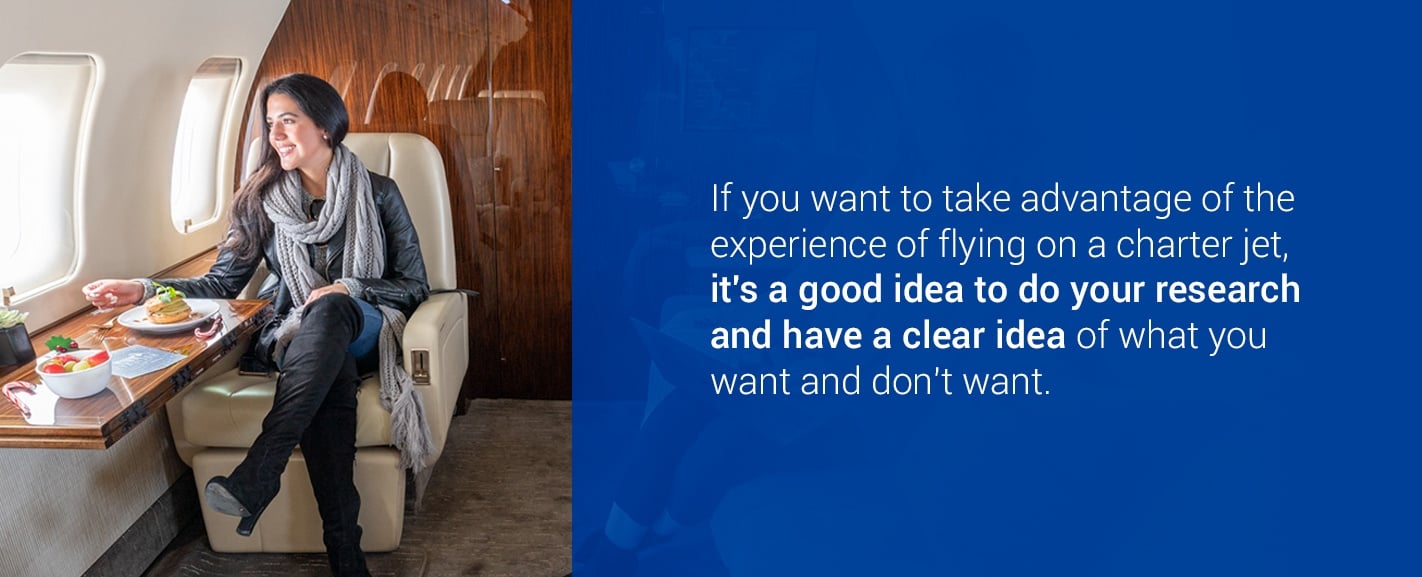An increasing number of travelers are choosing to fly private — and it’s easy to see why. Private aviation offers a convenient, luxurious flying experience, which many people value.
You may be curious about the onboard private jet experience. Our guide will provide a detailed overview of private jet travel so you know what to expect from the moment you step on board.
The Advantages of Flying Private
Whether you’re traveling for business or pleasure, you have several flight options available. Here are some of the top reasons to fly private:
- Convenience: Travelers can set their own schedules and choose the most convenient airport from which to fly. This reduces the travel time to the airport and eliminates endless waiting at gates and terminals.
- Privacy: You can truly relax and get comfortable on a private jet since you’re surrounded by the people you choose to bring on board. You can talk and work freely without worrying about invasion of privacy.
- Productivity: Without the distractions of other passengers, you can work in peace and may get more work done than you would on a commercial flight.
- Luxury: You can complete work tasks, talk to fellow passengers, and sleep in the spacious cabin. You can also use the ample space to store your personal and work items.
- Affordability: By taking advantage of special one-way flights, you can often experience all the benefits of private aviation at an affordable price, especially if you’re flying with a group.
The list of advantages stretches even further since many aspects of a charter flight can be customized to fit your needs and wants.
Amenities on Private Jets
The main reason people fly private is the freedom it offers. You can customize everything from the flight menu to the interior of the aircraft to accommodate your unique needs.
Most people are familiar with commercial air travel, including the rigid schedules, potential delays, cramped seating, and many other headaches that come with it. Those considering the private jet lifestyle may be excited about the benefits of a customized flight. Beyond the benefits, novice flyers may still have questions about what it is like to fly private. The following sections detail answers to some of the commonly asked questions about private jet travel.
How Does Flying Private Work?
Individuals or corporations schedule private flights via a charter company. Many charter companies have their own aircraft, while others rent the aircraft. Some companies that rent aircraft manage the aircraft for the owner, facilitate bookings, and ultimately give the owner a lease back. You can charter private flights to fit your schedule — unlike one-way flights, which rely on predetermined routes. One-way flights are those that have passengers on the way to a destination but not on the return journey. In some cases, customers can book a flight on a one-way flight for a discounted price. However, finding a one-way flight that fits all your travel criteria — such as your desired date, time, and location — is nearly impossible if you are doing the research alone. Finding the perfect one-way flight that fits your itinerary is easy if you work with an operator or broker.
You can schedule private flights as early as months ahead or as late as 24 hours before departure. Specifying your departure time allows you to plan your future trip or book a flight for the same day in emergencies. No ticket is necessary for private flights since you’ll get an email itinerary from the charter company. This itinerary also includes information about the flight crew and pilots.
While private jets are extremely convenient and you can book them at short notice, there are some time limitations. Private flights need time to prepare, so it’s unlikely you can get a flight within minutes. Depending on the aircraft’s location, it may be at least a day before you can board and take off. Additionally, it may take longer to give the plane and flight crew enough time to prepare the aircraft for safe flying.
Are Private Jets Faster Than Commercial Jets?
Depending on the aircraft and route, private jets typically travel faster than commercial aircraft. They are also afforded many time-saving privileges that shorten the overall length of the journey.
Private jets can fly out of almost any airport, big or small. Often, smaller airports that aren’t major hubs are more cost-effective. There are also many general aviation airports from which only chartered jets can fly, so passengers can choose the one closest to them and save time commuting. Once at the airport, you move from the terminal to the cabin quickly and take off soon after. Without needing to navigate giant, crowded runways and large numbers of passengers, private jets often end up in the air sooner than commercial jets.
Private jets also tend to fly higher than commercial jets. A higher altitude reduces the chances of dealing with air traffic and bad weather, both of which reduce the amount of time it takes to arrive at the destination.
One of the pros of flying private is the passenger can have more input about the flight — this includes the routes. Commercial airlines often cannot take a direct route, but private jets are not bound to the rules and regulations of large airlines and airports. If you want to get to your destination quicker, request a direct route. Similarly, you can request an indirect route if you want to enjoy a little extra time on the plane and enjoy the scenery longer.
Are Private Jets Safe?
Private jets are just as safe as commercial jets. The Federal Aviation Administration (FAA) outlines safety rules for both commercial and private jets. Specifically, all companies must ensure the aircraft is well maintained, inform passengers about safety procedures, and train knowledgeable pilots and staff.
The Transportation Security Administration (TSA) also has specific recommendations for fixed-base operators (FBO) — that is, the places from which many charter jets fly. TSA offers recommendations for pilots, crew, and aircraft mechanisms.
On top of these regulations, charter companies have their own ways of vetting staff and crew to ensure clients receive the best service. When researching a charter company, it’s a good idea to inquire about the experience of the pilots, particularly how many hours they’ve flown in the specific aircraft you’ll be using. You can also find out how the company vets its crew. It’s likely the company will be more than happy to explain how they are taking steps to ensure a safe and comfortable flight for you.
In addition, you can check the charter company’s ARGUS rating. ARGUS is an independent rating system for private jet operators that aims to help charter companies adhere to an internationally recognized standard. Companies that boast an ARGUS Platinum rating, like Latitude 33 Aviation, indicate to passengers and potential clients that they take safety very seriously.
Flying privately typically means you don’t need to travel with dozens of strangers. Passengers on a private jet often know each other and can enjoy time together during the flight.
Do Passengers on Private Flights Go Through TSA?
Yes, passengers aboard private jets go through security. However, removing shoes or separating liquids isn’t necessary — in fact, private charter jets enable you to carry greater liquid quantities. You can bring full-sized bottles of your cosmetics and shampoo, as well as sealed or unsealed bottles of alcohol or other beverages. Because of this, private jet security for passengers is often faster.
Instead of normal airport security protocol, passengers are searched at the terminal shortly before boarding the aircraft. Charter jets carrying 61 passengers or more must screen passengers and luggage before boarding. The requirements are different for light private jets, which typically seat between four and eight people. These jets are exempt from conducting the same inspection as commercial flight passengers.
What Can You Bring on Charter Jets?
Charter jet flights allow more freedom with luggage weight allowances. However, the size of the aircraft could impact how much baggage will fit on board. Since the baggage will be in the cabin with passengers, it needs to be able to fit in the space without blocking passageways. Otherwise, you can bring whatever you like on a charter jet.
Pets are welcome aboard a charter flight and can keep you company in the cabin. Like with commercial flights, you need to make sure your pet is up to date on required vaccinations, and you are responsible for obtaining any required documentation.
For international flights, you will need to make sure you have the appropriate documentation and meet the requirements of the arrival country. This can include getting a separate visa for your pet.
Can Private Jets Land Anywhere?
The short answer is yes, private charter jets have the privilege of landing at any airport in the country. It’s best to discuss your options with your aviation broker to see which airport is convenient and within your budget.
There may be fewer airports available for landing internationally. Charter jets must follow the rules and regulations of foreign countries, and the charter company may need to obtain permission to land at an international airport.
Can You Use Electronics on a Private Jet?
One of the pros of flying private is the opportunity to be more productive than you could on a commercial flight — even in first class. On private jets, you can bring your laptop, tablet, and phone and get work done in peace and comfort. Many private jets also offer Wi-Fi. If you need the internet to work or you plan to spend the flight browsing the web, you’ll need to request an aircraft with Wi-Fi capabilities.
While you can bring and use your electronics on a private jet, the Federal Communications Commission requires all passengers to switch electronics like telephones and tablets onto airplane mode while the aircraft is flying. This is especially necessary during takeoff and landing to ensure there is no interference with the aircraft’s navigation systems. The FAA is a little more lenient on this and suggests that electronics can be used during the flight if the aircraft crew deems they will not interfere with navigation or communication systems.
These regulations only apply to electronics that may interfere with communication systems, which means electronics like pacemakers, electric shavers, and portable recorders are exempt and can be used throughout the flight.
Do You Need a Passport or Visa on a Private Jet Flight?
Most charter jet flights are domestic, so a passport is usually not necessary. However, if you are planning to charter a jet to an international city, the immigration laws of that country still apply. You will be responsible for bringing your passport and visa to ensure entry.
Travel documentation also applies to any children or pets who may be traveling with you. It’s best to double-check the immigration requirements of your destination country and make sure you have all the appropriate paperwork ahead of time. This is especially crucial when it comes to visas since many of them require an application and take several weeks for approval.
When traveling on a private charter jet, customs and immigration are generally much quicker for many of the same reasons that security is quicker. The reduced number of passengers and the special terminal where charter jets land means officials can check and stamp in minutes.
Is Food Served on Private Flights?
Food can be served on private flights if the passengers request it. The perk of charter flights is you’re not limited to the same airplane food you’re likely to get on commercial flights. Instead, passengers can request almost any meal they want. More freedom allows passengers with strict dietary requirements to choose a meal they can enjoy.
Because private flights tend to be shorter than commercial ones, many passengers request simpler meals — like trays of fruits and vegetables or selections of cheeses that are easy to eat and share without reheating. However, requesting specific meals from specific restaurants is also a possibility if you desire.
The restaurant will need to pack food orders in a way that will stay fresh and allow for reheating on the plane. Some private jets have microwaves on board, while others have reheating ovens, so the packaging must be compatible with both. In addition, some restaurants decline to cater to private jets because their food will need warming up, impacting the quality.
Other considerations for private jet food are ease of eating and aroma. It’s best to avoid pungent foods, as the aroma will remain in the cabin until the aircraft lands and the crew opens the doors. It’s also a good idea to choose foods that are convenient to eat so you can reduce messes.
Regardless of what you want on the flight, there’s a good chance the charter company will oblige you. You should be aware you’ll be paying for the food itself in addition to the logistics of getting it to you. For example, if you want a specific meal from a restaurant, the meal price would include the cost of the food, as well as the gas and time the charter company uses to drive there and pick it up.
Are Seat Belts Still Necessary on Private Jets?
The FAA requires seat belts and emergency protocols, so even private jet passengers need to wear seat belts during takeoff, landing, and any other time the private jet crew deems it necessary. FAA regulations state that the crew must brief every passenger on board on how to properly lock and unlock their seat belt or seat harness before the aircraft can take off.
What Are the Toilets Like on Private Jets?
Private jet interiors vary in size, so some smaller jets don’t have bathrooms at all. This isn’t as much of a problem, considering many charter jet flights are just a few hours long. Passengers are simply advised to use the facilities at the FBO or at their destination.
Jets with toilets onboard have accommodations that range from luxurious and elegant to the bare minimum. Smaller jets may have a toilet behind a curtain. Others may have a standard bathroom similar to those on commercial planes but a little more enclosed — making them potentially uncomfortable for people who are bigger or taller than average.
A fully enclosed bathroom on a private jet usually includes a toilet, a sink, and a vanity mirror. These bathrooms usually have folding or sliding doors to make for easier access.
The bathroom facilities on a private jet vary by the model of the aircraft. It’s always a good idea to double-check whether a toilet is one of the included amenities and, if so, what sort of toilet it is. Even if your jet has a toilet on board, it may not be the most comfortable option, and you may opt to use the facilities at the FBO prior to takeoff instead.
Are the Seats Comfortable on Private Jets?
One of the greatest benefits of private charter jets is the luxury and comfort they provide. Private jets offer additional legroom and reclining space — even more than first-class commercial seats — mostly because private jets typically transport 10 or fewer people. With fewer passengers, you have more space to spread out, and this applies both to your body as well as your belongings, such as computers.
Some private jet models are even equipped with sofas or beds, allowing for ultimate comfort and the option to change positions with ease.
Experience the Luxury of Charter Jet Flights With Latitude 33 Aviation
With charter aircraft located throughout the nation, Latitude 33 Aviation is prepared to charter your next flight. We’re the only private jet operator in San Diego with an ARGUS Platinum safety rating, and we set the standard for private air travel. Our expert crew is available to answer all your questions about your next custom flight.
Get in touch with our concierge charter department by calling 864.660.0310. You can also request a quote today.






